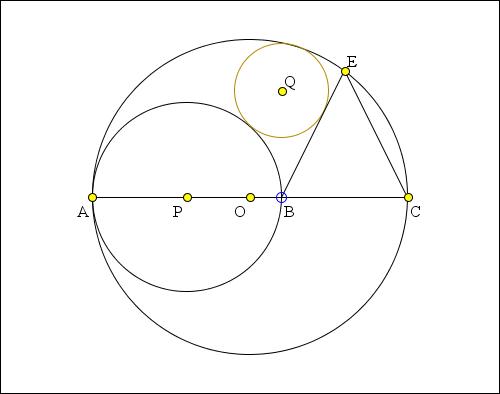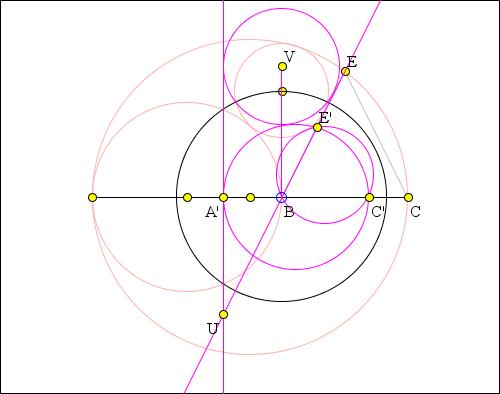Tangent Circles and an Isosceles Triangle
Solution by N. Bowler
The applet presents a solution to the following Sangaku problem: Given a circle S with center O and diameter AC and point B on AC. Form circle G with center P and diameter AB and an isosceles triangle BCE with E on the circle S. Circle W with center Q is inscribed in the curvilinear triangle formed by circles S and G and the line BE. Prove that QB is perpendicular to AC.

I shall use inversion. I shall denote the inverse of any object by the name of that object followed by a '.
First note that the problem is equivalent to showing that the circle with centre on the perpendicular from B, and tangent to BE and to G is also tangent to S. I shall still call this circle W.
Invert with respect to B, i.e., in a circle centered at B and some radius r, say.

Step 1: C'BE' will be similar to EBC and so isosceles. This is because
BC·BC' = r2 = BE·BE', such thatBC/BE = BE'/BC'. It follows that alsoBC'/C'E' = CE/BE, but in DBCE we haveCE = BE. Step 2: S' will be the circle on A'C' as diameter, and G' the tangent to it at A'.
Step 3: Let U be the intersection of G' with E'B. Then A'UE' = pi/2 - UBA' = pi/2 - E'BC' = pi/2 - C'E'B = UE'A' so A'UE' is isosceles.
Step 4: Let V be the centre of W'. Since W' is tangent to both G' and BE', V lies on the bisector of A'UB. So
VUB = A'UV = BVU and so also BVU is isosceles.Step 5: Let L be the centre of S', and call the radius of this circle R. Call the radius of W' r.
There are right angles everywhere, so we may now indulge ourselves with a Pythagorean orgy:
LV2 = LB2 + BV2 = (R - A'B)2 + BU2 = (R-r)2 + A'B2 + A'U2 = (R-r)2 + r2 + A'E'2 = (R-r)2 + r2 + A'C'2 - E'C'2 = (R-r)2 + r2 + 4R2 - BC'2 = (R-r)2 + r2 + 4R2 - (2R-r)2 = R2 + 2Rr + r2 = (R + r)2. So that W' is tangent to S' and so W is tangent to S as required.
Another solution makes use of inversion with negative power.
Inversion - Introduction
- Angle Preservation Property
- Apollonian Circles Theorem
- Archimedes' Twin Circles and a Brother
- Bisectal Circle
- Chain of Inscribed Circles
- Circle Inscribed in a Circular Segment
- Circle Inversion: Reflection in a Circle
- Circle Inversion Tool
- Feuerbach's Theorem: a Proof
- Four Touching Circles
- Hart's Inversor
- Inversion in the Incircle
- Inversion with a Negative Power
- Miquel's Theorem for Circles
- Peaucellier Linkage
- Polar Circle
- Poles and Polars
- Ptolemy by Inversion
- Radical Axis of Circles Inscribed in a Circular Segment
- Steiner's porism
- Stereographic Projection and Inversion
- Tangent Circles and an Isosceles Triangle
- Tangent Circles and an Isosceles Triangle II
- Three Tangents, Three Secants
- Viviani by Inversion
- Simultaneous Diameters in Concurrent Circles
- An Euclidean Construction with Inversion
- Construction and Properties of Mixtilinear Incircles
- Two Quadruplets of Concyclic Points
- Seven and the Eighth Circle Theorem
- Invert Two Circles Into Equal Ones
|Activities| |Contact| |Front page| |Contents| |Geometry|
Copyright © 1996-2018 Alexander Bogomolny
73572384
